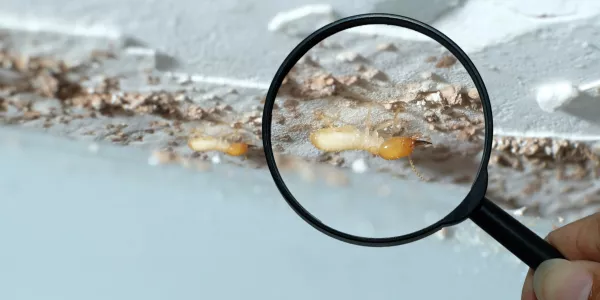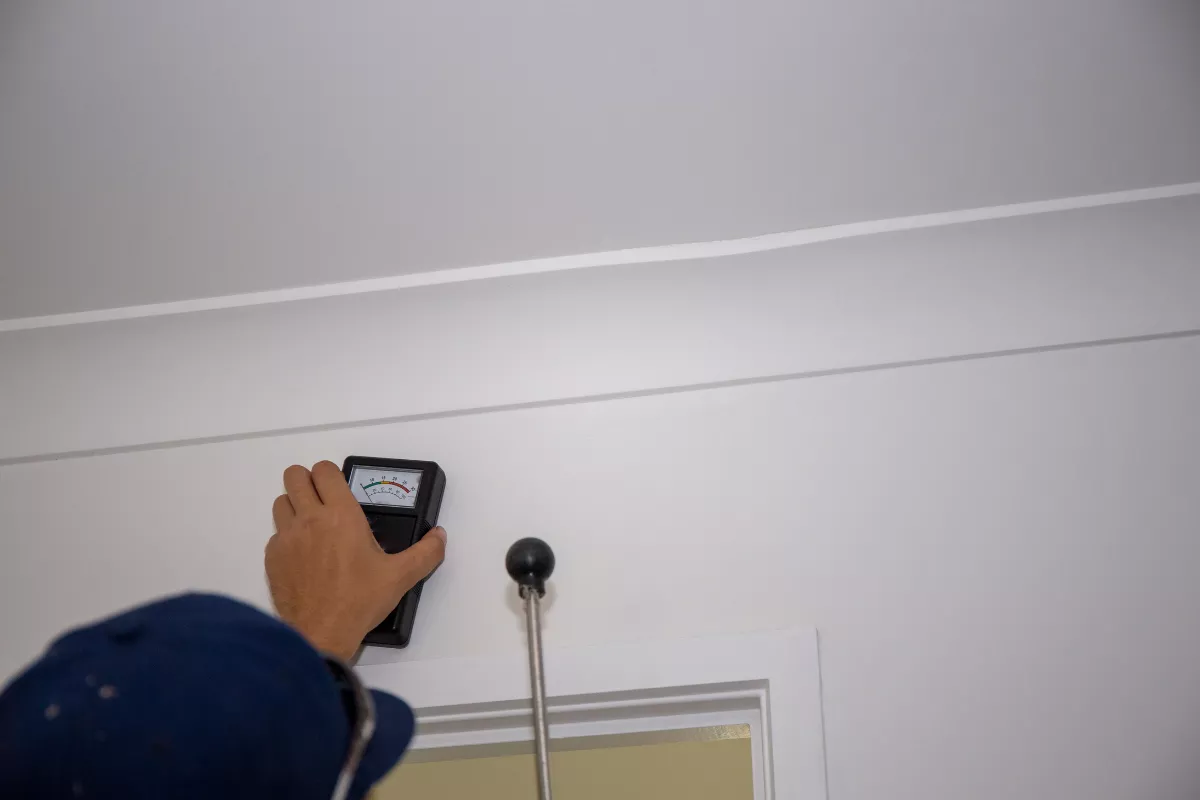Termites, often referred to as "silent destroyers", have the potential to inflict significant damage on your home without showing early warning signs. Grasping the subtleties of termite inspections is crucial in safeguarding your home's integrity and avoiding expensive repairs.
Here we will provide you with information about the complexities of termite inspections, addressing widespread questions and concerns to equip you with the necessary knowledge for protecting your residence.
A termite inspection entails a comprehensive evaluation by a local termite control expert who examines both the interior and exterior of your property for termite evidence.
What Does Termite Damage Look Like?
Termite damage can often remain hidden until it reaches a critical stage, as early signs are easily overlooked. These signs include wood that sounds hollow when tapped, paint that is cracked or appears to be bubbling, mud tubes on the building's exterior, and a powdery, fine dust near timber.
Such indicators might hint at a termite presence well before the damage to the structure becomes obvious. It's important to note that termites eat away at wood from the inside, making early discovery difficult yet essential.
As the infestation grows, the interior damage may start to resemble water damage, presenting as warped wood, swollen floors and ceilings, and areas showing signs of minor water exposure. Visible mazes within walls or furniture and a musty odor similar to mold or mildew can also signal a serious termite problem.
Can a House with Termites Be Saved?

Fortunately, homes affected by termites can usually be salvaged, particularly when the infestation is identified early on. Professional termite eradication techniques are very successful in removing termites from the affected structure.
Following such treatments, it's crucial to repair any damage and implement preventative strategies to maintain your home's long-term integrity. Nonetheless, the level of termite damage and how long the infestation has been present could influence the structural stability of the home, underscoring the importance of timely and expert intervention.
How Much Is a Pest Termite Inspection?
The cost of a termite inspection can vary widely depending on the location, size of the property, and the extent of the inspection required. Generally, homeowners can expect to pay between $75 to $150 for a professional termite inspection.
In some cases, companies may offer free inspections as part of a treatment package. Always inquire about the specifics covered in the inspection fee to understand the value you're receiving.
When Should I Get a Termite Inspection?
Scheduling an annual termite inspection is a prudent measure, especially for those living in regions susceptible to termite infestations. It's also wise to consider an inspection when buying a new home, observing any signs of potential termite damage, or following any treatment to confirm its success.
Regular checks serve as a fundamental safeguard against termite invasions. Understanding the importance of termite inspections, it becomes clear why they are necessary and when they should be conducted. Homeowners, particularly in warm and humid areas where termites thrive, are advised to undertake these inspections yearly.
Moreover, when acquiring a new property, a termite inspection becomes crucial and is legally required in many states, with the responsibility often falling on the seller to ensure it is completed before the sale concludes.
What Termite Inspectors Look For
While you might catch early signs of termite presence, it's often the case that by the time you notice, they've already inflicted significant damage on your home. This underscores the importance of regular termite inspections, as not all indicators may be visible or present at the outset.
Mud Tubes
These are essentially highways for subterranean termites, linking their colonies to their food sources. Composed of soil and wood particles, these tubes are about as thick as a pencil and serve multiple purposes, including protecting the termites from predators and preventing dehydration.
Although their presence strongly suggests subterranean termites, their absence doesn't guarantee a termite-free environment, as drywood termites do not construct these tubes.
Wood Damage
Hollow-sounding wood when tapped is a classic sign of termite activity. Termites compromise the structural integrity of wood, particularly the joists, leaving them hollow and weakened. Probing wood with a screwdriver can reveal hidden termite tunnels, which subterranean termites typically align with the wood grain.
Swarm Evidence
Subterranean termites swarm to establish new colonies when their numbers grow or conditions become favorable. Signs of a recent swarm could include seeing the swarm itself or finding discarded wings, especially near sources of light like windows or lamps.
Frass
This term refers to termite droppings, which appear as small, granular pellets or wood shavings. Frass is commonly found near baseboards, window sills, and door frames, indicating termite presence.
Bubbling Paint
Paint that bubbles or peels could be a sign of subterranean termite damage, as they affect drywall and allow moisture to seep behind the paint, causing it to buckle. However, paint can bubble for other reasons as well, so this isn't a definitive sign of termites.
Live Termites
Spotting live termites can be rare outside of swarming events. Distinguishing termites from ants is crucial, with termites having creamy white bodies and belonging to different castes within the colony, including workers, soldiers, and winged swarmers. Differences in wings, antennae, and body shapes can help identify termites from ants.
What Areas Do Termite Inspectors Inspect?
Termite inspectors concentrate on areas susceptible to termite infestations, such as foundations, wooden elements, basements, crawlspaces, attics, as well as external structures like decks and porches that have direct contact with soil.
Their approach is customized to the distinct habits and entry preferences of various termite species. For subterranean and Formosan termites, the focus is primarily on the interior and exterior perimeters of a home, including the foundation, basement, and lower levels, along with any accessible attic and crawlspace areas.
In regions prone to drywood termites, the inspection extends to exposed wood, hardwood floors, attics, crawlspaces, and eaves, with a possibility of inspecting wooden furniture for signs of infestation.
If an inspector suspects termite activity in areas that are difficult to access, they will record these concerns and suggest methods for a thorough examination, which might involve the use of specialized equipment. In some cases, to confirm termite activity, the inspector may recommend drilling small holes in walls or other parts of the structure.
What Happens When Your Termite Inspector Finds Termites?
If your termite inspection reveals an infestation, immediate action is crucial. Ignoring the presence of termites, even for a short period, can significantly increase the extent of their damage in most cases.
The chosen method for dealing with the termites, known in professional circles as termite treatment, varies based on how serious the infestation is. Typically, this involves the use of baiting stations which are equipped with termite-killing pesticides. These stations are strategically placed around the property in areas where termites are likely to congregate or could potentially pose a threat.
If baiting stations prove ineffective, the next step might be the application of a liquid barrier treatment. This method entails digging a trench around the home's perimeter and treating it with chemical agents like fipronil, which is also used in certain ant control products. Termites crossing through this chemically treated zone are eliminated before they can reach the home.
The cost for termite extermination can vary widely, depending on factors such as the size of your home, the severity of the infestation, and the specific treatment plan devised by your inspector or exterminator. On average, homeowners might expect to spend around $600 for a termite treatment session.
People also ask
Is termite inspection necessary for new homes?
Regardless of whether a house is newly built, it remains essential to inspect the premises for potential termite presence. While the structure itself may not host termites, the surrounding yard and garden could be at risk. Therefore, arranging a termite inspection is a prudent measure to prevent future termite problems.
How long does a termite inspection take?
The duration of the inspection varies based on the property's size, ranging from 30 minutes to as much as two hours. A comprehensive termite inspection will encompass the foundation, attic, crawl space, fences, any woodpiles, and other areas on the property that could attract termites.
Can termite damage be completely repaired?
Indeed, termite damage is repairable through either the replacement of compromised wood with new material or by reinforcing the weakened wood with additional support. The extent of the damage determines the approach to repairs, with more significant damage often necessitating the removal and substitution of the affected wood.

 Marcio Vasconcelos
Marcio Vasconcelos





